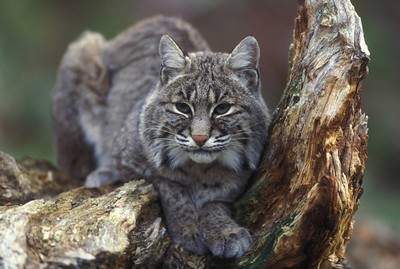Do you need to know a few of the laws for hunting bobcats in Oklahoma? While this article lists some more important ones, state and local regulations often change. It is your responsibility to know and adhere to all federal, state, and local laws when hunting bobcats.

In Oklahoma, the bobcat hunting season runs annually from December 1 through February 28. There is no daily limit. However, there is a season limit of 20 bobcats per issued license. Both a resident hunting license and resident fur license are required.
Purchase an Oklahoma hunting and fur license here.
Check out all the Oklahoma hunting seasons.
Related: Learn the three vital steps to a successful bobcat hunt here.
Related: Interested in hunting coyotes in Oklahoma? Read the rules for it here.
Related: Learn the rules for hunting fox in Oklahoma.
General rules for hunting bobcats in Oklahoma.
Can you use decoys and electronic callers while bobcat hunting in Oklahoma?
Electronic calls or electronically activated calls may be used.
Check prices for electronic callers on Amazon here.
Amazon sells a variety of predator hunting decoys here.
Is hunting bobcats in Oklahoma legal with a suppressor?
Silencers are legal in Oklahoma. Hunting? Silencers are legal for hunting both game and non-game animals in Oklahoma.
Can you hunt bobcats at night in Oklahoma?
No, night hunting is not permitted for bobcats.
Bobcat pelts must be tagged.
No bobcat or river otter pelt may be held in possession after 10 working days after the close of furbearer season by the taker or buyer, sold, purchased or bartered within Oklahoma, nor taken out of Oklahoma, without having first affixed a permanent tag to the pelt. This tag shall serve as an export tag. The tag must be affixed by an authorized employee of the Department or designated private tagging agent. It is the responsibility of the possessor of the bobcat or river otter pelt, not the Department, to ensure that the pelt is legally tagged. No untagged bobcat or river otter harvested in another state may be possessed in Oklahoma. Tags are available from any game warden, wildlife biologist, state fish hatchery, Department field office and specifically designated private tagging station.
Designated private tagging stations may charge a fee of 75 cents per tag. Bobcat or river otter export tags will not be affixed after March 14.
Sale of bobcat carcasses.
Skinned carcasses or parts of legally acquired furbearing animals and coyotes (excluding the hide/pelt/fur) may be purchased, bartered, traded, sold or offered for sale.
Can you kill a bobcat destroying livestock on your property in Oklahoma?
Nothing in the regulation prevents the killing of furbearers actually found destroying livestock or poultry. In addition, nothing in this regulation prevents the running or chasing of coyote, bobcat, fox or raccoon with dogs for sport only, except on those public lands where such activity is prohibited. Bobcats and foxes taken with this exemption cannot be removed from the property. Only furbearers taken within season and with a fur license may be sold or removed from property.
As always, your best advice for the legality of taking a bobcat without a permit and/or out of season is to speak with your local game warden of animal control officer.
Related: Learn how to read bobcat sign here.
How much does it cost to go hunting bobcats in Oklahoma?
While prices for a guided bobcat hunt will vary due to a variety of circumstances, the average price run between $350 to $500 per day.
Please note: The companies below are listed because they offer online pricing. There is no relationship between them and Thepredatorhunter.com.
Western Oklahoma Trophy Outfitters.
Bobcat hunting with dogs in Oklahoma.
At night:
Headlighting / Spotlighting
No person may attempt to take, take, attempt to catch, catch, attempt to capture, capture, attempt to kill, or kill any deer, feral animal or other wildlife, except fish and frogs or except as provided by law, by the use of a vehicle-mounted spotlight or other powerful light at night, by what is commonly known as “headlighting” (or “spotlighting”) or use any light enhancement device (night scope).
Provided, however, nothing in this code shall prevent one from possessing a .22 caliber rimfire rifle or .22 caliber rimfire pistol and a light carried on his person while in pursuit of furbearers with hounds during the legal open furbearer season, while possessing a valid hunting license and fur license, unless exempt.

